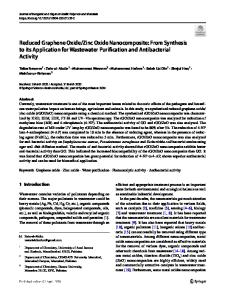Synthesis and characterization of zinc oxide nanoparticles and zinc oxide/cellulose nanocrystals nanocomposite for photo
- PDF / 2,632,737 Bytes
- 12 Pages / 595.276 x 790.866 pts Page_size
- 0 Downloads / 377 Views
(2020) 5:18
ORIGINAL PAPER
Synthesis and characterization of zinc oxide nanoparticles and zinc oxide/cellulose nanocrystals nanocomposite for photocatalytic degradation of Methylene blue dye under solar light irradiation Shreya Modi1 · M. H. Fulekar1,2 Received: 5 May 2020 / Accepted: 25 July 2020 © Springer Nature Switzerland AG 2020
Abstract In this paper, we report the synthesis and development of zinc oxide (ZnO) nanomaterials for the removal of Methylene blue dye. During the study, Allium Sativa skin (garlic skin) was used to evaluate their potential for the synthesis of ZnO NPs. The remaining biomass of garlic skin was further processed to isolate cellulose. The purest form of the cellulose was obtained, and further acid hydrolysis was carried out to obtain nanocrystalline cellulose (CNCs). The ZnO NPs and CNCs were used to develop ZnO/CNCs nanocomposite. The formation of nanomaterials has been confirmed by UV–visible spectroscopy, UV DRS, XRD, FTIR, SEM-EDAX, TEM, BET, AFM, and TGA. The comparative study was carried out for the removal of Methylene blue dye using synthesized and developed nanostructures under solar light irradiation. Different concentrations of dyes 10 ppm, 25 ppm, and 50 ppm were taken during the study. TEM confirms the formation of the rod- and hexagonalshaped nanoparticles having an average size of 7.77 nm for ZnO NPs and 59.51 nm for ZnO/CNCs nanocomposite. BET analysis also confirms the increased surface area of nanocomposite than bare ZnO. Bare ZnO can degrade about 65.87% of dye, while 88.62% degradation was achieved in the case of ZnO/CNCs nanocomposite for 10 ppm dye concentration under solar light irradiation. It was observed that the photocatalytic degradation of Methylene blue dye is strongly dependent on the pH of the solution. The highest dye degradation was achieved at alkaline pH (pH 9). A kinetic study was carried out for the photocatalytic degradation which denotes the pseudo-first-order type of reaction. Our work showed a rapid, costeffective, eco-safety, and suitable method for the development of different potential nanomaterials for the removal of organic contaminants.
* Shreya Modi [email protected] 1
School of Nano Sciences, Central University of Gujarat, Gandhinagar, Gujarat 382030, India
Centre of Research for Development, Parul University, Vadodara, Gujarat, India
2
13
Vol.:(0123456789)
18
Page 2 of 12
Nanotechnology for Environmental Engineering
(2020) 5:18
Graphic abstract
Keywords Nanotechnology · Nanoremediation · Cellulose nanocrystals · Kinetics · Bandgap · Photocatalyst
Introduction Effluents discharged from dying and textile industries cause serious problems to the surrounding environment and living beings due to its high contamination of color and heavy metals. Therefore, it is necessary to treat dye contaminated effluent before discharge to the environment. Conventional methods for the removal of dyes have significant disadvantages [1]. Nanotechnology is emerging as a new and advanced field of research that deals with the syn
Data Loading...










